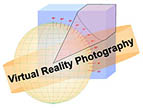

![]() Ask the VR Photography Experts
Ask the VR Photography Experts
![]()
Q: I shot a series of exterior panoramas for a local client using a Bronica GS-1 (50mm 6x7cm lens w/polarizing filter, NPS 160 neg. film). Unfortunately, the stitched panoramas have some pretty strong banding in the sky area, which is almost impossible to retouch out in Photoshop. How do I avoid this?
![]()
A: In general, you'll want to avoid shooting panoramic images with a polarizing filter on your lens. Polarizers work by filtering out light whose wavelengths are not oriented in the same direction as the polarizer. Thus, they can be used to minimize reflections off of glass surfaces and to darken blue skies. However, their effect is most pronounced at perpendicular axes from the light source.
Thus, the blue sky is darkened most through a polarizer from directions 90-degrees away from the sun (although the amount of "darkening" depends upon the orientation of the filter itself - most polarizing filters can be rotated in their mounts for control of the effect). It has far less effect when pointed directly toward or 180 degrees opposite the sun. This is one of the reasons why you get more pronounced sky banding with the filter on your lens. The sky in your panoramas are darkest 90 degrees off the axis of the sun.
![]()
The banding that you get between stitched images probably has less to do with lens design and light fall off toward the edges, than it does with simple vignetting due to the addition of a filter in front of the lens. Most professional camera systems (including Bronica) have extremely well designed lenses, which exhibit very little light fall off near the edges of the frame. Such aberrations tend to be most pronounced in ultra-wide, rectilinear lenses, and are almost negligible in standard wide angle or normal lenses (your 50mm lens for a 6x7cm format is equivalent to a 26mm lens in 35mm film format).
The problem is that the addition of a threaded filter to the front of a lens causes slight vignetting in the corners of the image, because the frame holding the filter's glass protrudes very slightly into the field of view of the lens itself. For most stand alone photographs, this slight vignetting is almost imperceptible. However, when you are matching the density of the edge of one shot with a non-edge area of another overlapping image, the slight differences become much more apparent and show up as banding between stitched frames. This is most noticeable in areas of consistent plain color, such as blue sky, rather than in more visually "busy" areas of the image.
![]()
Bottom line... shoot your panoramas (whether with film or digital cameras) without a filter on the front of your lens, unless its absolutely necessary to protect the lens. And avoid using a polarizer for panoramas. You can always intensify the colors or darken the sky digitally after the fact, but trying to fix the stitching problems arising from use of the filter is much more difficult.
As for your existing shot for your client, it might take less time to go out and reshoot it and rescan it, than it will to pay for the Photoshop and retouching time needed to make it look the way you want.
Also, unless there's a compelling reason to shoot in medium format, you'll find significant cost savings and flexibility shooting with 35mm or digital equipment (particularly lab scanning fees).
- Scott Highton